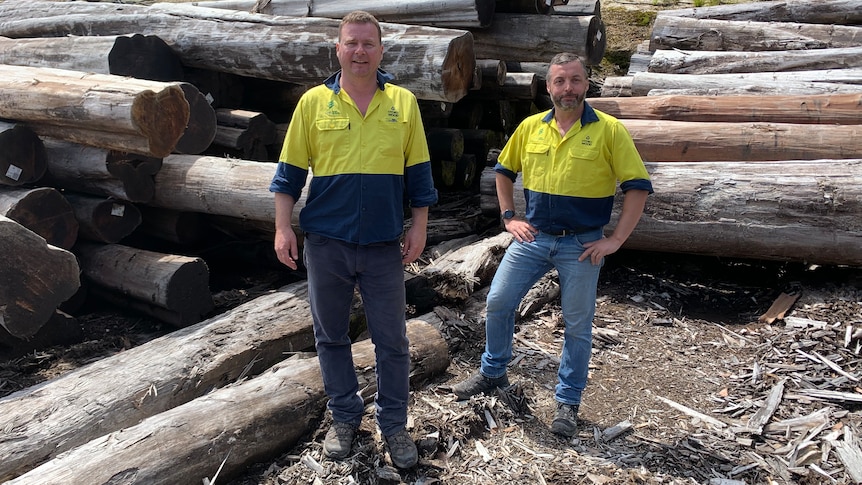Many a friendship has begun at the pub over a sherbet or two.
But for mates Andrew Morgan and Dave Wise, a chance meeting at the university bar led not only to a long friendship, but also the creation of Australia’s first drowned timber company.
It’s logging but with a big twist.
The pair extract dying logs from under the surface of Lake Pieman, which was dammed for hydropower in 1986, flooding Tasmania’s remote north-west forests.
Sometimes the logs are more than 20 meters deep
.
A time-consuming process
If you are scratching your head thinking, “If this is so genius, why hasn’t it already been done?”
It turns out extracting logs in tannin-stained, pitch-black water in freezing conditions in a remote part of the wilderness is a bit tricky.
For the Hydrowood lads it meant making up a lot of the processes themselves.
They invented a complex and robust underwater harvester, and had to find workers with unique skills, as well as maneuvering through a lot of red tape.
“We’ve definitely had some challenges,” Mr Morgan said.
“We had to do the feasibility study, design the equipment, build it, find our fantastic staff that run the operation, work out how to drive the timber, how to market it and keep it going into the market.”
It took three years from creating the concept to pulling up the first tree.
“I think one of the biggest learnings I’ve had, is business takes time,” Mr Morgan said.
“I think the media is to blame somewhat, in that those success stories that someone’s come up with an idea and sold it for x-gazillion dollars in a week. That’s not the real world.”
A chance flight
Like many great moments of ingenuity, necessity was the mother of invention.
The pair were forced to come up with a new business during the global financial crisis, when the major plantation companies they had been working for collapsed.
Up until that point, managing plantations on behalf of big companies had been the bulk of their bread and butter.
Mr Morgan said they lost all of their clients when those companies closed.
“We really needed to seek new sources of revenue and new clients,” he said.
They needed a new idea and as luck would have it, Mr Wise, a pilot, spotted it when he was flying out of the north-west one day.
“I saw the trees sticking out of the water and thought ‘Is that a potential resource?'” Mr Wise said.
“[We] had a look at what they were doing in Canada with the same use of drowned timbering, fundamentally in hydro lakes. Then we started looking at the feasibility of doing it in Tasmania, and nearly 10 years later, here we are.”
Taking on the controversy
Tasmania has a long history in the forest industry and was one of the pioneers in hardwood plantation development.
But harvesting native forests is controversial.
Mr Wise and Mr Morgan said that it was their point of difference: they use a product that would otherwise go to waste.
“It is deteriorating slowly underwater,” Mr Morgan said.
“This product’s been sitting here for 30 years, everyone else has looked at it and decided it had no value until we came along and had a crazy idea that we could actually salvage it.
“So yeah, it’s a waste product.”
It is that story which has attracted a niche and lucrative market.
Companies are drawn to the sustainability as well as the beauty of the timber, which is getting harder to source.
It’s also why they charge a pretty penny.
“The timber that we’re pulling out is obviously more expensive than your standard terrestrial logs,” Mr Morgan said.
“It’s not a cheap process to pull them out. In general… it’s 20 to 30 per cent more expensive than a standard piece of timber of the same species.”
Demand for a ‘waste story’
Furniture designer Simon Ancher was one of their first clients and said his customers were increasingly asking questions about where timber was sourced and how.
“I think it’s really important,” he said.
“In this current climate change discussion and growing awareness around our consumption of resources and so forth, we really need to pride ourselves for the planet as much as for ourselves and be knowledgeable about where things come from and why.
“To make use of this lost resource in a really positive way — without cutting down old growth forests but actually just extracting it from this frozen state — is a fantastic story and really positive one in making the most of available resources.”
Mr Morgan said he sometimes marvels at how far his mate’s crazy idea has taken them.
“One minute I can be talking to a contractor, talking about harvesting a forest, the next minute I’m talking to a world-renowned designer,” he said.
To learn more about Hydrowood and other regional innovators, watch Movin’ to the Country on ABC TV, Fridays at 7.30pm or any time on ABC iview.
.
